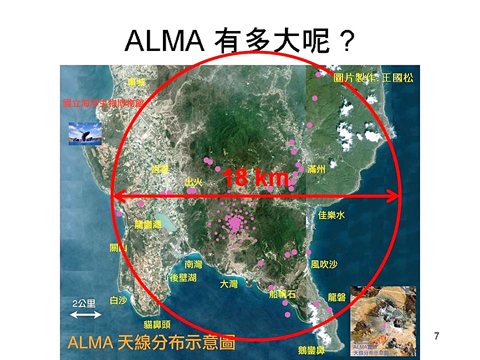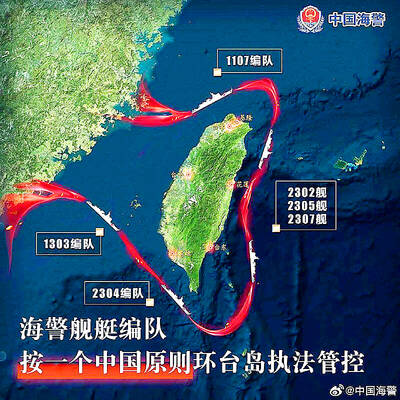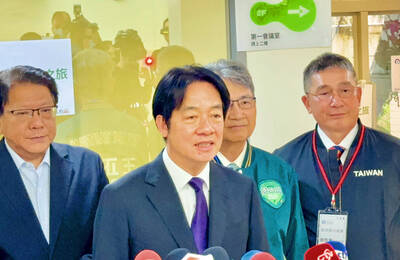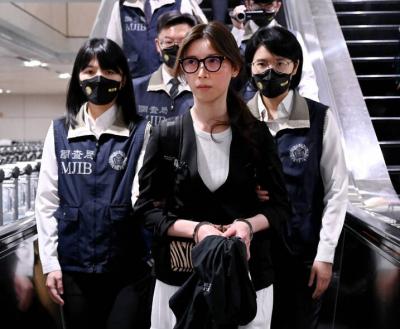Answers to some of the astronomy world’s long-debated questions — such as the formation and structure of stars and galaxies when the universe was young — may soon be unveiled thanks to a groundbreaking collaboration involving Taiwanese astronomers, the National Science Council (NSC) said in a press conference yesterday.
The Atacama Large Millimeter/submillimeter Array (ALMA) observatory, a space telescope composed of 66 giant antennas scheduled for completion in 2012, and one of the world’s most advanced tools for exploring cooler parts of outer-space is almost complete, the NSC said.
The telescope — a collaboration between US, Canadian, EU, Japanese and Taiwanese scientists — successfully observed Mars in a “test drive” on April 30, ALMA project scientist Lu Sheng-yuan (呂聖元) said.

PHOTO PROVIDED BY LIU SHENG-YUAN OF ACADEMIA SINICA
“This is a milestone for the extremely complex project — being in Chile’s Atacama desert 5,000m above sea level and involving so many mechanical components,” Lu said. “[Since 1995] we worked on producing, transporting and assembling the antennas, but we didn’t know if we would really see astronomical bodies through [the telescope].”
Taiwan’s contribution to the project — besides US$32 million in funding — is the development of the antennas, as well as the “front end,” the first electronic element through which the signals from space are received, Lu said.
The revolutionary space telescope is an interferometer, meaning that information collected by two or more of the antennas are processed into a single, high-resolution system, Lu said.
In the April 30 observation, two of the three completed antennas were spaced about 30m apart to collect signals from Mars, Lu said.
“This is kind of like detecting a person’s location from listening: With one ear, it is difficult to detect where the person is talking from, but with two it is easier,” he said.
When all 66 antennas are completed, the distance between them will be able to be adjusted according to the resolution the scientists desire, Lu said.
“The longer the distance between two antennas, the better the resolution, but the smaller a region we can observe. The maximum distance two antennas can be placed apart is 18km, which would simulate the effect of a [traditional] telescope 18km in diameter,” he said.
In addition to being very high resolution, the wavelengths that the antennas detect enable scientists to observe cooler parts in the universe, meaning galaxies and stars that are at early stages in their formation, Lu said.
“This means we can explore the formation of them, and confirm or reject current theories,” he said.
As for the future of the project, Lu said that Taiwanese researchers are entitled to up to 60 percent of the telescope’s observation time when it is completed, pending researchers submitting good proposals.
However, he is optimistic that the nation’s scientists can get sufficient time with ALMA: “Though we are a young team, I don’t think our [quality of research] would be worse than other countries.”

Taiwan would benefit from more integrated military strategies and deployments if the US and its allies treat the East China Sea, the Taiwan Strait and the South China Sea as a “single theater of operations,” a Taiwanese military expert said yesterday. Shen Ming-shih (沈明室), a researcher at the Institute for National Defense and Security Research, said he made the assessment after two Japanese military experts warned of emerging threats from China based on a drill conducted this month by the Chinese People’s Liberation Army’s (PLA) Eastern Theater Command. Japan Institute for National Fundamentals researcher Maki Nakagawa said the drill differed from the

‘WORSE THAN COMMUNISTS’: President William Lai has cracked down on his political enemies and has attempted to exterminate all opposition forces, the chairman said The legislature would motion for a presidential recall after May 20, Chinese Nationalist Party (KMT) Chairman Eric Chu (朱立倫) said yesterday at a protest themed “against green communists and dictatorship” in Taipei. Taiwan is supposed to be a peaceful homeland where people are united, but President William Lai (賴清德) has been polarizing and tearing apart society since his inauguration, Chu said. Lai must show his commitment to his job, otherwise a referendum could be initiated to recall him, he said. Democracy means the rule of the people, not the rule of the Democratic Progressive Party (DPP), but Lai has failed to fulfill his

A rally held by opposition parties yesterday demonstrates that Taiwan is a democratic country, President William Lai (賴清德) said yesterday, adding that if opposition parties really want to fight dictatorship, they should fight it on Tiananmen Square in Beijing. The Chinese Nationalist Party (KMT) held a protest with the theme “against green communists and dictatorship,” and was joined by the Taiwan People’s Party. Lai said the opposition parties are against what they called the “green communists,” but do not fight against the “Chinese communists,” adding that if they really want to fight dictatorship, they should go to the right place and face

A fugitive in a suspected cosmetic surgery fraud case today returned to Taiwan from Canada, after being wanted for six years. Internet celebrity Su Chen-tuan (蘇陳端), known as Lady Nai Nai (貴婦奈奈), and her former boyfriend, plastic surgeon Paul Huang (黃博健), allegedly defrauded clients and friends of about NT$1 billion (US$30.66 million). Su was put on a wanted list in 2019 when she lived in Toronto, Canada, after failing to respond to subpoenas and arrest warrants from the Taipei District Prosecutors’ Office. Su arrived at Taiwan Taoyuan International Airport at 5am today on an EVA Air flight accompanied by a